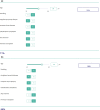To screen or not to screen? The development of a prediction model for aorto-iliac stenosis in kidney transplant candidates
- PMID: 34416037
- PMCID: PMC9290083
- DOI: 10.1111/tri.14013
To screen or not to screen? The development of a prediction model for aorto-iliac stenosis in kidney transplant candidates
Abstract
Screening for aorto-iliac stenosis is important in kidney transplant candidates as its presence affects pre-transplantation decisions regarding side of implantation and the need for an additional vascular procedure. Reliable imaging techniques to identify this condition require contrast fluid, which can be harmful in these patients. To guide patient selection for these imaging techniques, we aimed to develop a prediction model for the presence of aorto-iliac stenosis. Patients with contrast-enhanced imaging available in the pre-transplant screening between January 1st, 2000 and December 31st, 2018 were included. A prediction model was developed using multivariable logistic regression analysis and internally validated using bootstrap resampling. Model performance was assessed with the concordance index and calibration slope. Three hundred and seventy-three patients were included, 90 patients (24.1%) had imaging-proven aorto-iliac stenosis. Our final model included age, smoking, peripheral arterial disease, coronary artery disease, a previous transplant, intermittent claudication and the presence of a femoral artery murmur. The model yielded excellent discrimination (optimism-corrected concordance index: 0.83) and calibration (optimism-corrected calibration slope: 0.91). In conclusion, this prediction model can guide the development of standardized protocols to decide which patients should receive vascular screening to identify aorto-iliac stenosis. External validation is needed before this model can be implemented in patient care.
Keywords: cardiovascular disease; kidney transplantation; recipient screening.
© 2021 The Authors. Transplant International published by John Wiley & Sons Ltd on behalf of Steunstichting ESOT.
Conflict of interest statement
The authors have declared no conflicts of interest.
Figures



References
-
- Tonelli M, Wiebe N, Knoll G, et al. Systematic review: kidney transplantation compared with dialysis in clinically relevant outcomes. Am J Transplant 2011; 11: 2093. - PubMed
-
- Chaudhri Y, Horrow MM, Zaki R. Vascular steal of renal transplant: sonographic diagnosis. J Ultrasound Med 2006; 25: 939. - PubMed
-
- Norgren L, Hiatt WR, Dormandy JA, et al. Inter‐society consensus for the management of peripheral arterial disease (TASC II). J Vasc Surg 2007; 45: S5. - PubMed
-
- Brekke LB, Lien B, Sødal G, et al. Aortoiliac reconstruction in preparation for renal transplantation. Transpl Int 1993; 6: 161. - PubMed
MeSH terms
LinkOut - more resources
Full Text Sources
Medical

